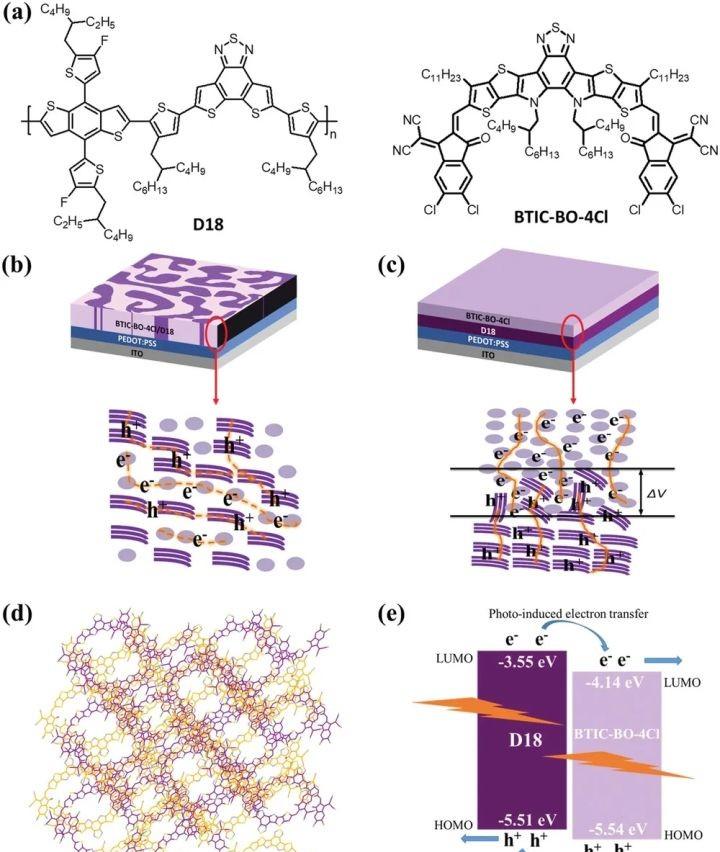The researchers prepared two novel organic solar cells by isomers ITIC-2Cl-δ and ICTIC-2Cl-γ quasiplanar heterojunctions, with a photoelectric conversion efficiency (PCE) of up to 17.6%.
1. Preface
The planar heterojunction (PHJ) containing the material given to the receptor is generally formed by multiple spin coatings, and tiny nanoscale heterojunction (BHJ) regions may be generated in the PHJ film due to the swelling of the solvent and the diffusion effect of the molecules. Therefore, the researchers defined the structure as a quasiplanar heterojunction (Q-PHJ). Although the efficiency of Q-PHJ type organic solar cells (OSCs) lags behind that of BHJ OSCs, they still have certain advantages. The active layer containing the donor forms a separate bilayer structure, and the D/A interface produced by contact between the two can effectively dissociate the exciton. In this case, the resulting holes are transmitted in the donor and electrons are transported in the acceptor, reducing the need for charge recombination during device operation, and this vertical phase separation is easier to control than the morphology of BHJ.
On the other hand, the long lifespan and diffusion distance of excitons ensure that most excitons diffuse to the D/A interface for dissociation. With the advent of novel non-fullerene receptors such as IT-4F, Y6, and Y6-BO with long-range exciton diffusion, the photoelectric conversion efficiency (PCE) of Q-PHJ OSCs further approaches or exceeds that of BHJ OSCs. Analysis of the single crystal structure of some receptor derivatives shows that these molecules have a 3D interpenetrating network structure composed of strong interactions of adjacent molecules, which further promotes the transfer of excitons and charges in multiple directions, which can be used to generate excellent Q-PHJ OSCs.

Figure 1: Related molecular structures and different heterojunction morphologies, etc
2. Introduction
In order to prove the superiority of this 3D network receptor, professor He Feng's research team of Southern University of Science and Technology recently prepared two novel Q-PHJ OSCs based on the isomers ITIC-2Cl-δ and ITIC-2Cl-γ. From its crystal stacking diagram, it was found that the 3D network structure of ITIC-2Cl-γ had better charge mobility and a more linear fill structure than THATIC-2Cl-δ. The study found that the PCE of THE PHJ device based on D18:ITIC-2Cl-γ was 12.44%, which was much larger than that of the PHJ device based on D18:ITIC-2Cl-δ (PCE was 9.74%). In addition, the researchers further optimized the device to prepare Q-PHJ OSCs based on D18:BTIC-BO-4Cl. Compared to BHJ OSCs, the Q-PHJ device achieves up to 17.60% PCE, one of the highest efficiency values among Q-PHJ OSCs reported to date.
Figure 2: Photovoltaic performance of the device in question
Studies have shown that Q-PHJ thin films have fast charge transfer and exciton dissociation. Excitons produced by D18 and BTIC-BO-4Cl have sufficient diffusion distances to reach the D/A interface. Based on the transient absorption spectrum, Q-PHJ films show rapid dissociation. Holes and electrons are transported independently in D18 and BTIC-BO-4Cl, the high equilibrium carrier mobility in Q-PHJ devices reduces charge recombination, and good charge transfer also helps reduce energy loss in Q-PHJ devices. By reducing the single-layer deposition of the Q-PHJ active layer of the mixed phase and improved vertical phase separation, it helps to improve device performance and stability.
Figure 3: Grazing-incidence wide-angle X-ray spectroscopy of a related molecular device
3. Summary
In summary, through the comprehensive study of BHJ and Q-PHJ devices based on D18 and BTIC-BO-4Cl, this work has obtained important guidance for the preparation of efficient Q-PHJ OSCs, which can accelerate the commercialization of OSCs devices. The research has been published in advanced materials, a top international journal, entitled "17.6%-Efficient Quasiplanar Heterojunction Organic Solar Cells from a Chlorinated 3D Network Acceptor".
Keywords of this article: organic solar cells, planar heterojunction, bulk heterojunction, charge transport, exciton dissociation, D18, BTIC-BO-4Cl.
D18:2433725-54-1
Y6-BO:2389125-23-7